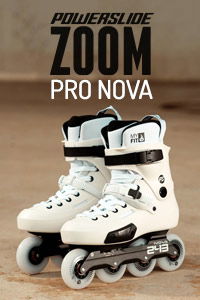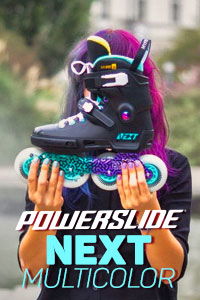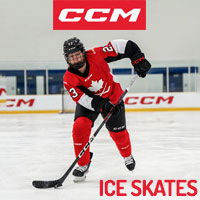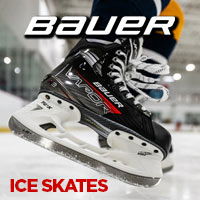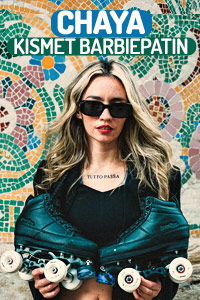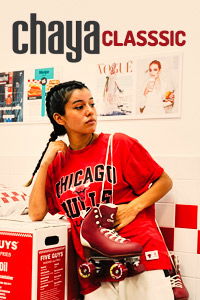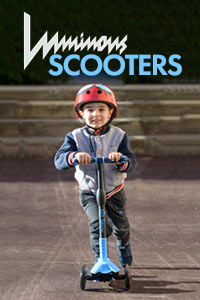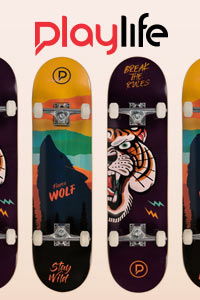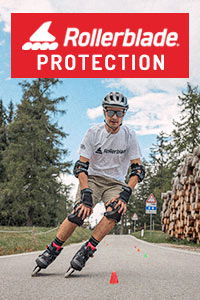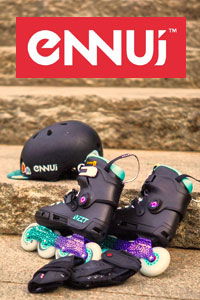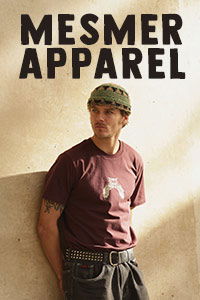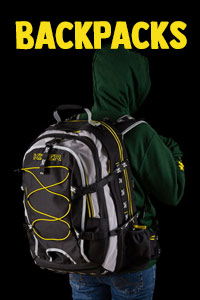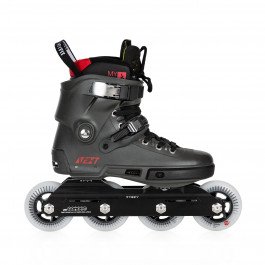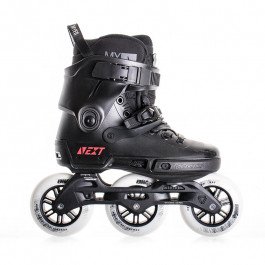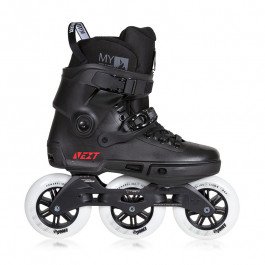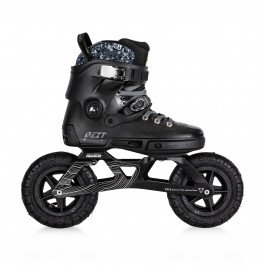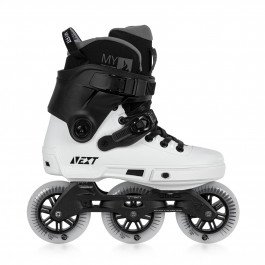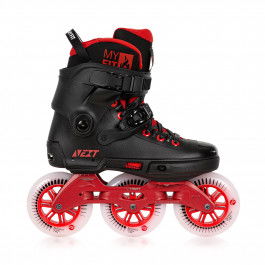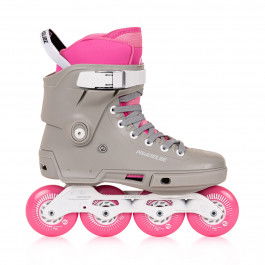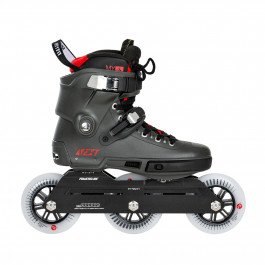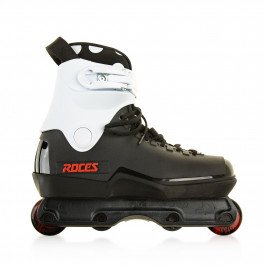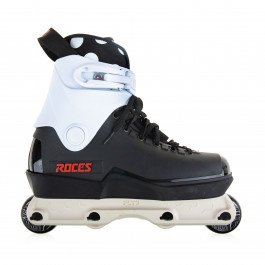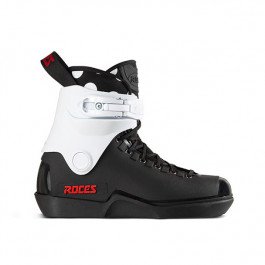Every person with feet bigger than average surely knows how hard it is to find a pair of decently fitting shoes – not only because of the foot being long, also because it is usually wider and have higher instep. For the purpose of this article, let’s agree that “big foot” means EU45 or bigger.
In case on inline skates things get more complicated, as more factors are at play. To put things right out of the gate – if you have big feet, you most likely are a tall person who also weights more than average human. Men are the most numerous among this group and they are by default more muscular than women (as in, if both do not deliberately build muscle mass via exercise) which increases weight further, making it easy for them to go over 100 kg without even a slight excess of fat tissue. This is why skate boot must be solid and supportive to secure ankle and being able to withstand increased forces during use.
Another thing massively impacting skating experience is the frame length. It can be a deal breaker for newcomers and unfortunately, even now, after more than three decades of rollerblades going mainstream, skates in which big sizes do not receive appropriately long frames to provide a stable wheelbase are still common. A boot of size EU47 coupled with a frame that is designed as best trade-off between agility and balance for size EU42 is simply unstable. It isn’t a problem an experienced skater cannot overcome (although longer frame will still make skating more enjoyable for them), but beginners have extremely hard time learning technique using such equipment.
Most important rule: you cannot get just any pair of skates.
Taking above factors into account, we have prepared a guide about skates you should consider if you happen to have big feet and look for a pair to start your journey with the sport. All skates included must be in line (no pun intended) with below three requirements:
- Boot is strong enough to support above average body weight.
- Skate comes with rigid and strong aluminium frame. The only exception are aggressive inline frames which are composite but have thicker walls than equivalents in fitness skates, plus lowered centre of gravity (less flex) and H-block which acts as a reinforcement in the middle, in addition to being a part to grind on.
- The frame for given model is always long enough (for example in skates that come with 4x90 wheel setup) or big sizes have longer version than smaller ones to ensure good level of stability.
Last but not least – we are taking a perspective of people who never skated or have a minimal amount of experience into account. Thus, do not be sour that we have not included popular skates such as FRX 80 or FR1 80 on the list. These models, unfortunately, do not have frame length adjusted to the size of the shell. Inexperienced person with big feet won’t feel comfortable with level of balance in them. We sincerely hope that FR Skates will finally follow the example of others and changes approach. As of now, it is what it is - very few FR skates come with frames longer than 243 mm.
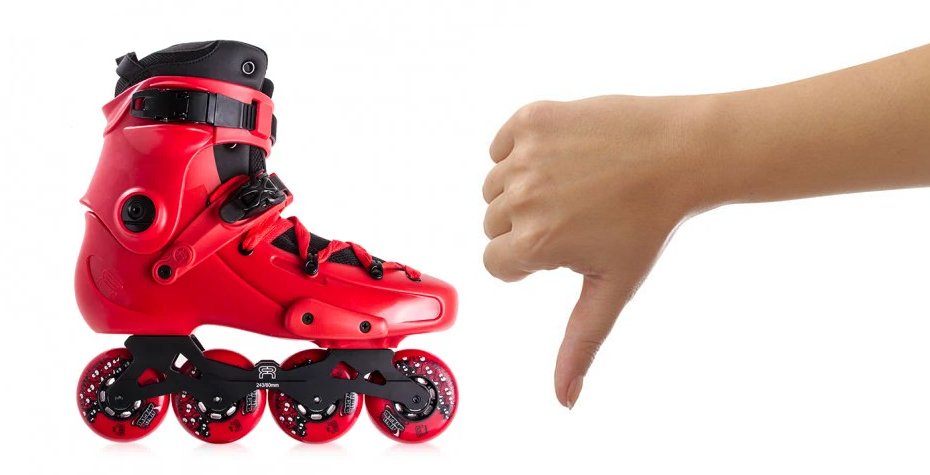
We have separated skates into three categories (with a bonus at the end): fitness, freeskate and aggressive.
Be warned that skate availability may vary and we cannot guarantee that all of models listed here are in our shop and in size you may be interested in – everything depends on actual stock levels (both our own and manufacturers’). It is also worth to know that if you are looking for a pair of fitness skates, you may want to take a look at freeskates too, as they are the most versatile type and can be used for workout just fine. If everything else fails, you can always try grabbin a pair of aggressive inline boots and buy freeskating frame using UFS mounting standard separately to build your own setup.
That’s not all, though – there is also a wild card at play, one which can be your gateway into skating if no boot available fits you, somehow.
Seeing that sizing is quite often not very accurate, we are providing a maximum value of mondo point – read what it is and how to measure your own mondo point here.
WARNING: considering the subject (and issues quite often present in choosing skates for big feet) we are giving some hints on how to modify certain skates on your own to make more room in them. However, be aware that these procedures most often void warranty and you do them at your own responsibility!
Fitness skates for big feet.
Market is flooded with skates of this kind, but don’t fool yourself that it is easy to find ones that are made in big sizes and can support above average body weight.
Unfortunately, quality comes with a price and thus, we won’t be recommending cheap skates as it does not make any sense. Not only they would wear out quickly, they are potentially a danger to your health. Too much flex in the cuff area can cause a serious ankle or even a knee injury! Joint sprain isn't much fun.
K2 F.I.T. Alu and K2 VO2 S (mondo point up to 32 cm)
The company focuses mostly on fitness skates and what they call x-training – basically a more intense workout for demanding skaters who want performance, but without sacrificing comfort. The cheaper F.I.T. Alu and more expensive VO2 S, both being offered for mondo point up to 32 cm.
In case of F.I.T. boots, the design is identical to lower end skates from the K2 line, so we can recommend them only to lighter skaters – but who said that you cannot have bigger feet and be very slim and the same time? Aluminium frames versions are preferred choice and it is best to pick up a model for 4x84 wheel setup at minimum to ensure decent frame length.
For those who are of stronger build (or want to have better performing skate in general) VO2 S are the way to go.
Apart from visual gimmick in form of one-sided frame exposing wheels in all of their beauty, these skates have more robust outer skeleton. Overall, boot is more “heavy duty”, one may say, designed to provide better energy transfer.
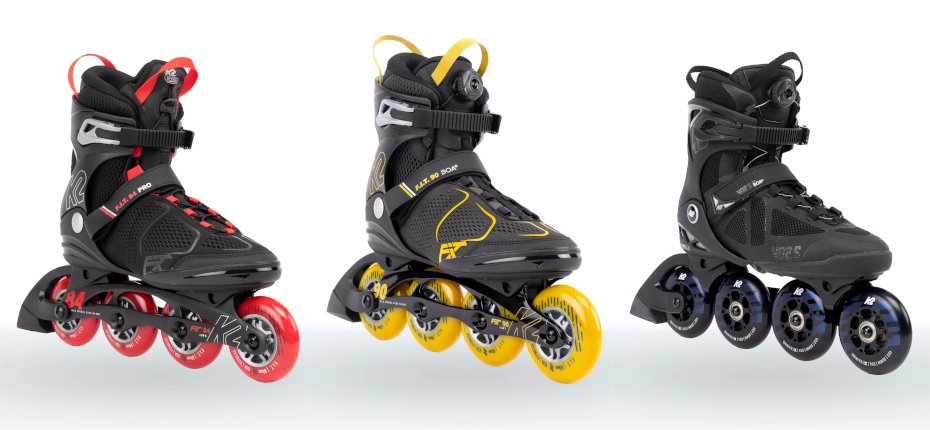
The minimum wheel setup in case of VO2 S models is 4x90, which is good news as shortest possible frame length in such scenario is 273 mm (in reality it is a bit longer in K2 skates). You won’t have any balance problems when it comes to back and forth stability. You can also choose one of models with bigger wheels and in turn, longer frames, but we feel that base model should be a sweet spot for majority of users when it comes to difficulty.
What else do you need about K2 skates? In comparison to other brands’ fitness skates, they force you to maintain correct skating stance a bit more.
People fall in love with K2 skates due to comfort. They are lightweight and fit like a pair of nice running shoes, even use the same materials. K2 was the first company to come up with softboot concept and since then, they are putting the comfort first when designing their skates.
All of these K2 skates come with a brake.
Rollerblade Macroblade (mondo point up to 31.5 cm)
They are pretty similar to K2 models but fit differently and come with different frame lengths according to size. The outer skeleton and base of the boot are rigid and robust, strong in heel and ankle area, so they deliver decent amount of support.
It is worth to note that even the entry level of the line, Macroblade 80, comes with 265 mm frame for mondo point up to 28.5 cm and 280 mm one for longer feet. In addition, it is possible to fit 84 mm wheels in there, even though stock ones are 80 mm.
Macroblade are safe bet, because Rollerblade cares about delivering stable wheelbase. Even their three wheeled version of Macroblade, coming with 3x100 setup, have 274 mm long frame, whereas competition use 250 mm or shorter ones in their own skates for this wheel count and size.
All Macroblade skates come with a brake. Rollerblade is top-tier manufacturer when it comes to quality and these models should satisfy needs of any fitness skaters. Their modern, stylish design is also a plus and stands out among fitness skates which quite often look a bit kitsch.
Rollerblade Maxxum, also called Maxxum Edge (mondo point up to 31.5 cm)
These are royalty among fitness skates and have a lot in common with urban skates. They are based around hardboot concept and their shell is the very same as in modern Twister (previously called Twister Edge), but coming with more minimalistic cuff design, stronger 45 degree straps and lacking side slider. You won’t have a chance to bend your ankles to the sides in these skates, they simply won’t allow that.
Maxxum are designed for hardcore fitness enthusiasts who skate A LOT. Their strong components are allowing you to try more ambitious things like jumps and slides, too! In addition, their freeskating heirloom means that you are able to change the frame for another made for 165 mm mounting. Just be careful with that, as there’s no guarantee that frame made by another company will sit properly centred under the boot. If you consider swapping the frames for a different set, drop the shop an email asking for them to check how given frame model fits the boot in your size.
Maxxum are premium level when it comes to fitness skates. The 4x90 version comes with 280 mm long frame and a brake. For newcomers, it is recommended to go for this one over 3x125 version, which have noticeably longer frame, higher center of gravity and lacks a brake.
Last but not least, as in every hardboot, right fit matters a lot here. These skates (like Twister) fit narrow to medium feet. If you are experiencing just a tad bit of pressure, replacing stock liner with thinner one can help (we cover this option at the end of article) but for people with really wide feet it is definitely an “avoid” skate.
Powerslide Phuzion Argon (mondo point up to 30.3 cm)
Phuzion boot is a high end of fitness softboots. Powerslide are releasing new models based on this boot very frequently, but not all of them come with frames long enough to fall into scope of this article, so always read specs sheets carefully.
When it comes to technology and execution, Argon boot is almost as good as it gets. It provides excellent, above-average ankle support. The padding is made of high quality memory foams, boot comes with patented Trinity frame mounting system which connects the parts together using three screws instead of usual two (or rivets).
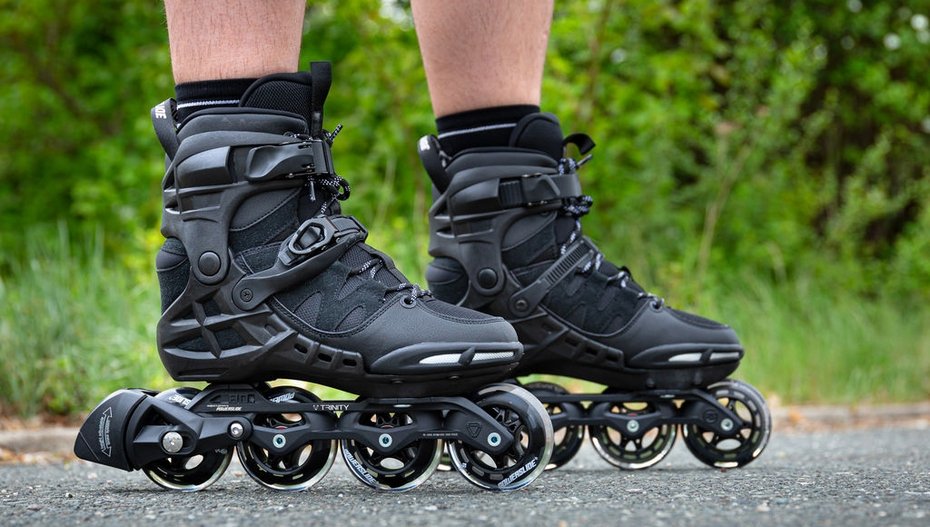
In contrast to K2 and Rollerblade softboot skates, you can change the frames in Argon. It is actually a viable option, seeing that Powerslide offers a wide range of affordable Elite Casted AL and Elite Casted MG models – so if you decide that you want to try a different wheel setup sometime down the line, the path is open. Check all available Trinity frames here.
Trinity mounting also results in lower centre of gravity and more stable base for push, giving you more control and better energy transfer.
If you choose one of Argon 80 models, it will come with 275 mm long frames in bigger sizes. You can fit up to 90 mm diameter wheels in there (skates come with 90 mm stock), so it is easy to upgrade to a faster setup.
Things get complicated in case of three wheeled skates (triskates). If you are thinking about 3x100 setup, most likely the frame is going to be too short. Things are better looking in case of 3x110 models, as they come with 250 mm frames at minimum (not disastrous, but not great either) and some of the new models (ones with Syncro brakes, mostly) sport 270 mm frames, which are excellent pick.
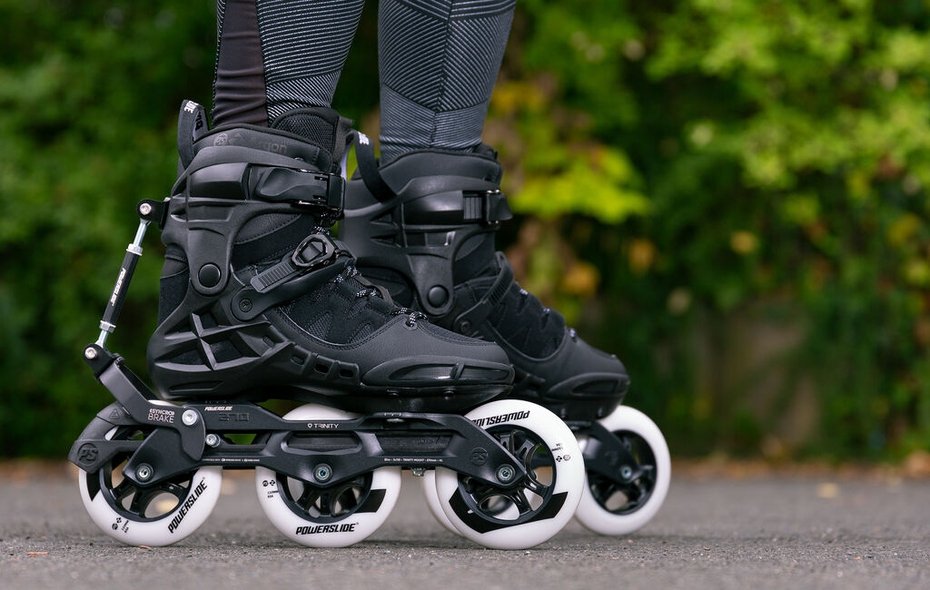
As in case of most fitness skates, brake is included.
Freeskates, also called freeride skates or urban skates (for big feet, of course).
This is hands down the most versatile category of skates, allowing you to perform variety of tricks and, depending on wheel setup, even skate long distances. They are based around the concept of rigid boot with strong frame, which makes them a great pick for people with heavier built, so it is worth to pick them even if all you want to skate is fitness.
FR Skates FR1 90 and UFR 90 Intuition (mondo point up to 30 cm in skates with FR liner, up to 32 cm in ones with Intuition)
The FR boot is highly popular and for a reason – it is a solid skate, even though it is (relatively speaking) pretty old design. UFR is almost the same skate, with some material added under the heel to make it UFS compatible. Two models listed here are very similar in function, coming with the same shell shape and 4x90 wheel setup in 273 mm long frames. It’s a good choice and will last you years of use.
The differences between two models boil down to three things:
- Regular FR skates use 165 mm mount spacing with raised heel. Thanks to aluminium plates with 7 holes for screws embedded in frame mounting point of the shell, they offer great level of compatibility with frames made for this bolt spacing.
As we stated before, UFR shell have additional material beneath the heel. Aluminium plates are gone, but the skate is compatible with UFS mounting standard. In fact, there’s an aggressive skate based around this boot and if you pick any of freeskating UFR models, you can add the soulplate part later on. Important thing to note is complete lack of frame position adjustment option – UFS simply does not allow for that. On the upside, it is almost guaranteed that any UFS compatible frame will be centred properly under the shell. - UFR Intuition model comes with premium Intuition liner. The Canadian company creates best in class liners for skiing, water sports and inline skating. Their patented high density closed cell foams allow liners to be thin, supportive and comfortable at the same time. Because it takes significantly less space inside the shell, the maximum mondo point of UFR Intuition is whole 2 cm bigger even though both skates use the same shell sizes!
- Frame in FR 90 is flat setup, meaning that all wheels are on the same level. UFR 90 Intuition have rockered setup, where outer wheels are raised by 1 mm in relation to inner ones. This imitates the ice blade curve and gives slightly better agility.
FR skates are of medium width, but have a very large opening at the top. This makes them a great choice for skaters with high instep, who experience pressure points at the top of the foot in more enclosed shells. Both skates do not have brake included, but you can buy one separately.
Last but not least, the FR line of skates is very popular, with plenty of models using the exact same shell shape: FRX, FR3, FR2, FR1 and UFR all fit the same (excluding versions with Intuition liners) so even if a skate in size which interests you won’t be available in a shop, you can try different edition to see how the boot fits you.
Powerslide Next (mondo point up to 30.5 cm)
Probably the most divisive skate listed here. It is a “love or hate” boot. Orginally it was designed to fit slim to medium width feet with rather low instep, although new premium variants tend to come with Reaction liner, which gives you a bit more room than a bit pillow-like, older Recall model. The skates are highly configurable and a lot can be done to tweak them to your preferences.
The Recall liner is what causes people to bounce off these skates in most cases. It has been designed to adjust to your anatomy after getting warm thanks to body heat, with break-in period giving you personalised fit. Boot is made with control and performance in mind.
Unfortunately, a lot of people fint Next too tight when trying them on - this is because foams weren't given time (and proper conditions) to adjust. The break-in process can be shortened by heat-molding the liners, but it is not something you can do in the shop or even right after receiving the skates via delivery, if you want to have an option to return them.
Our client advisor and resident skating geek, Gosia Trześniewska from Bladeville Warsaw team, says that Next aren't selling well as first pair of skates, but are very popular pick among more experienced users, who are familiar with freeskating and seek better performing, closer fitting boot than wider alternatives.
Like in most of Powerslide’s skates, we are getting a Trinity mounting system here, making the skate lower to the ground, more stable and easier to control. Plus, compatible with a really wide variety of frames, of course! The MyFit liners are heat-moldable and we highly recommend doing it.
As Next are flagship hardboots of the brand, there are plenty of options when it comes to frame and wheel types. Of course, we are interested in ones that come with frames long enough to give stability in our scenario.
The 4x80 versions are obvious pick here, as starting with size EU44-45 (skates have dual sizing, reflecting their true shell size) and going up, they come with 275 mm long frames. Just like in case of other Powerslide skates using this solution, you can upgrade to 90 mm diameter wheels later on.
If you want to go for 90 mm right from the start, Next 90 do exist as well as new Next 90 Charcoal version, which comes with super solid Combat Rocker frames – giving you an option to change wheels’ position in relation to each other. Combat Rocker 90 frame is longer than most 4x90 mm frames, measuring 291 mm.
When it comes to triskating options, we are offered a surprisingly decent choice here. Most of Next 110 editions sport 270 mm long frames starting with size EU44-45. There’s also a Next 110 Charcoal version with a different model of Combat Rocker frame, measuring 290 mm.
Next do not come with a brake, but for majority of models, you can get one. The only exception are models coming with Combat Rocker frames, which are not compatible with any brake because of their rockerable spacers.
Last but not least – Next are basically the only hardboot freeskates you can get in a boot only version, which is basic one, but allows you to configure a setup to your liking. They are compatible with all Trinity frames.
There’s one additional trick up Next’s sleeve – the shell have even surface beneath your foot, so you can take shock absorber out and skate the boot just fine like that. Why do that, though? To lower the foot’s position and make more room for instep. In some cases, this can greatly increase comfort. Powerslide endorses this officially and new Reaction liner comes with shock absorber attached by Velcro. Models with Recall liner have plastic insert with heel pad glued to it, but you can skate without it just fine.
Powerslide Zoom 80, also called Zoom 80 Pro (mondo point up to 30.3 cm)
We must start with saying that Powerslide is doing a terrible job when it comes to Zoom skates naming. There are two kinds of these skates – cheaper one with very basic frames riveted to the boot and more high end, with Trinity system and frames. We are covering the second here, as models with riveted frames do not have different lengths for bigger boot sizes and wheelbase is short.
Even though there are multiple varieties of Zoom, from our perspective the 4x80 one makes the most sense. That is because, once again, we are getting 275 mm long (max 90 mm wheel diameter) frame, this time for boots of size EU43-44 and bigger.
When it comes to triskating variants, the longest frames found among them measure 250 mm – not disastrous, but not great either. Powerslide are releasing new editions of their skates frequently, so it is possible that we’ll see something better suited for people with big feet in foreseeable future. But as of now - go for 4x80 mm version
The Zoom boot, contrary to popular opinion, is not the biggest shells on the market, but certainly one of biggest among freeskates. They are relatively wide and provide generous fit for high instep feet.
When it comes to parts, Zoom are a notch below Next, but with adequate drop in price, so it is a fair deal. The main differences are lower grade wheels, bearings and more basic liner. The Pro editions like Zoom 110 Pro Nick Lomax released back in season 2021 are an exception - it came with parts of higher quality than ones found in most Next editions.
Zoom skates comes without a brake, but you can buy one separately.
Rollerblade RB Cruiser and RB Pro X (mondo point up to 32 cm)
These are one of the most popular freeskates sold in our shop and for a reason – excellent quality at fair price. The boot is of highest volume out of all urban skates listed here and intended for people with regular to wide feet, with regular to high instep. If you have slim feet or low instep, it is better to look for other skates.
Last two sizes, EU47 and EU48 (they share the same shell) come with 261 mm long frames. It is as low as one mounted in smaller sizes (243 mm long), so there’s no option to use it with wheel setup bigger than 4x80.
It is very important to check which year the skates you order were made, as bigger frame is used since 2022.
There are three differences between these models.
First and most important one is the liner. Pro X received a thicker one with different shape of foams, it is also equipped with eyelets on top so you can lace it. Seeing that boot fits a bit tighter, people with really wide feet opt for basic version of the skate quite often.
The second difference is 45 degree buckle. Pro X uses the same one as top tier Twister Edge skates. It is a ratchet “pump” solution, sometimes called micrometric, which means that you have very precise level of control over tightening. It also comes with a bit of additional protection to prevent damage during falls.
Cruiser come with worse solution, unfortunately. Do not get us wrong – it holds your heel down in place well. The issues lies in how you tighten it. You slide the strap into lock and then you have to push a bigger lever down. It is the same concept as buckles used on cuffs, only redesigned to be slimmer and better suited to use lower on the boot. Thing is, if you want to get it closed really tight, you must put a significant amount of force into pushing the lever down. Fortunately, replacing this buckle with a different one is trivial.
Last but not least – the wheels. Cruiser come with wider wheels made out of lower quality urethane skates feel pretty slow compared to pricier model, which comes with very good, mid-tier Rollerblade Supreme wheels designed for urban skating.
Both versions come with a brake.
Rollerblade makes a triskate based on this boot (Rollerblade RB 110 3WD), however there is an issue with it. Frame measures 255 mm – not bad, but in big sizes it is not centered properly under the boot and is pushed too much to the front.
This may not be an issue for experienced skaters - some may even like it, as it improves maneuverability. However, the shifted centre of balance does make it hard to skate for beginners, making them falling back. This frame position requires a proper skating stance, with your weight shifted toward the toes.
It is possible to overcome this with access to right tools, but it isn’t that easy. First of all, you need to make threads in additional holes which are already drilled in metal plates in mounting points (only middle one is factory threaded). Then, you have to make rectangular plates out of 3 mm thick (at least) aluminium flat profile and drill holes in them, so you can put them between frame and boot. This will allow the front wheel to spin freely.
It certainly isn’t a job for everyone and you shouldn’t be forced to modify the skate out of the box to compensate for a design flaw. Thus, this mod should be considered as a last resort option, if no other boot on the market fits you and you absolutely mus have the 3WD version with original Rollerblade frame.
Alternatively, there are frames on the market that fit this boot better, seeing that they have more than a single pair of slots for mounting screws, so you can place them more to the back. Endless Blading makes a hybrid model for this boot, coming with longitidunal mounting slots, allowing for precise adjustment (it is a hybrid model, taking either 4x100 or 3x110 setup with possibility of 3x125 on some boot sizes). Too bad Rollerblade has not redesigned their own frames in such way.
Our recommendation - get one of 80 mm versions if this will be your first pair of skates. You can upgrade to 3x110 frame later on.
Rollerblade Twister, also called Twister Edge (mondo point up to 31.5 cm)
These skates are made for narrower feet, but if you have higher instep, they will accommodate that too. These are premium freeskating model in Rollerblade’s catalogue and their every part is high quality. It is a super solid gear, worth the asking price and one of the industry’s best designs for urban skating.
It is really pointless to write an essay here - Twisters are more than worth the asking price and stand as one of the best freeride skates, no matter which edition you pick. If you'll find them comfortable and well fitting, get them. There are no cut corners in terms of quality here.
They come with longer frames starting with EU44.5 size and going upwards. It is low profile 255 mm frame – not bad by any means, but could be a bit longer considering target audience of this article. The frames won’t accept wheels of diameter higher than 80 mm, even though axle spacing is enough to fit 84 mm ones – at least not without doing a hard modification to frame, removing some material from the front lateral bridge. Skates come with a brake in the box.
Twister boot doesn’t have the same issue as RB line when it comes to frame mounting points placement and thus, 3WD version is a viable choice for people wearing large sizes. We are getting the same frame, 255 mm long and fitting three 110 mm diameter wheels.
Overall, Twister 3WD are one of the best three wheeled freeskating models money can buy. This version of skate does not have a brake included, but it is possible to attach one of after market models.
Aggressive inline skates for big feet.
Surprisingly, for such a niche activity, the choice of boots suitable for people with big feet is very generous here!
In theory, these skates are not really a good pick for simply rolling around because of small wheels. Many stock setups come with antirocker setup, where only two wheels per skate touch the ground. This makes them very slow and hard to turn.
Aggressive inline skates are obviously made for tricks, especially the so called grinds – sliding on ledges and rails. A huge plus of aggressive frames is the fact that every manufacturer offers at least two sizes (S/L) and plenty of models available in three (S/M/L). Thus, we do not have to worry about frames being too short.
In addition, most skates are available in boot only version in addition to complete setup, allowing you to choose frames, wheels and bearings of your liking.
Apart from frames designed for aggressive, these are many UFS compatible ones made for urban skating on big wheels (almost all configuration options, from 4x80 up to 3x125!) or even hybrid frames allowing you to mix these styles together. There’s nothing standing in the way of building an urban skating setup based on aggressive boot if you find it fitting you better than most of freeskates out there.
We won’t cover frames here, as these change quite frequently. The only exception are Roces skates, which come stock with their usual frames and never with any third-party models. The below list is focused mostly on fit.
GAWDS Tim Franken Pro and Team II plus other skates based on the same shell (mondo point up to 30.5 cm)
GAWDS isn’t a big brand, but it does have a solid backing of Powerslide/Disroyal owner, Matthias Knoll and uses the same technology as these two companies. The boot in question is a rework of older USD VII skate. Fit wise it is the most universal boot ever created by USD thanks to high overall volume. There’s some degree of elasticity to its plastics, making it very comfy. A good pick for wide feet with high instep.
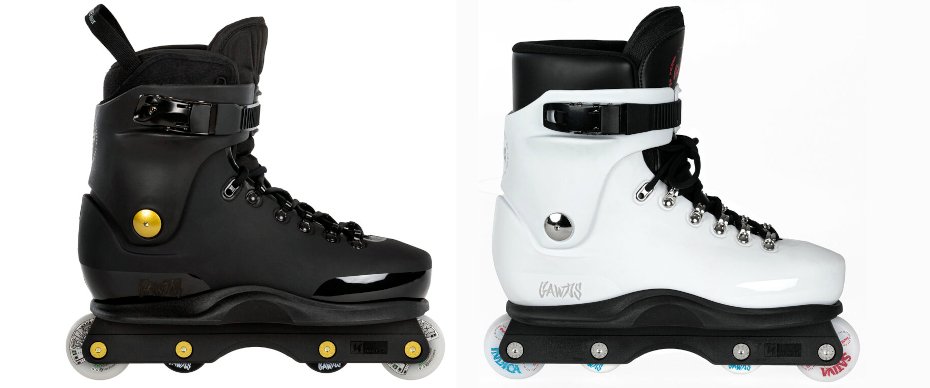
The liner depends on the model you go for – similar to frames, this part changes frequently between editions. Rule of thumb is that Pro models come with higher quality, more advanced liners – Tim Franken’s come with MyFit Prime, which is top tier product among MyFit range. It is on the thinner side, made out of more rigid foams and heat-moldable, whereas Team version get much simpler, more puffy model.
It is also very important that GAWDS skates still use the same soulplates as USD VII. These were created to be easy to grind on even for beginners. It is valued as one of the best designs in whole industry.
If you have wide feet with high instep - this boot won't let you down.
Razors Genesys (mondo point 30.5 cm)
These skates are now a true old-school model and times of their widespread popularity are definitely long gone, but this doesn’t change the fact that it is a solid, proven design which “just works”. They have one of the most spacious shells in the industry, great for people with wide feet and high instep. It is also almost bombproof, with solid and reliable soulplates. A big plus is their very competitive pricing. Even though Genesys has seen last release of a pro skate based on this boot 10 years ago and are now considered a "budget" model, they still remain a good pick.
The biggest issue of Genesys is their liner, which is very basic and thick to compensate for high volume of the shell. If we put a slimmer one inside, we can gain a whole size up. The stock one breaks-in eventually, but if you have wider feet, it may feel snug at first.
When it comes to quality of materials, it is obvious that these are not premium skates, but they are adequate, meaning - good enough for aggressive inline. There's no need to worry about skates breaking, cracking and so on. Souplates are relatively wide and they are fast, while placement of backslide plate forces you to do tricks the proper way and bend your knees.
Among aggressive skates, Genesys are like a workhorse – there is zero finesse to them, they aren’t of beautiful design, but they get the job done. You shouldn’t be disappointed especially considering that good deals on them are available quite often.
Razors SL (mondo point up to 30 cm)
Younger design than Genesys, SL are both slimmer and lighter. They still are not what one would call slim skates, though. The SL is an abbreviation of “superlight”, not “slim”. These skates are quite unique in their design, seeing that they lack bottom of the shell – our feet rest directly on soulplates which are attached to it. This reduces the weight and places your feet closer to the frame, wheels and surfaces you grind, giving you better control and feel on tricks. It also makes them sounding super nice on landings, giving you that satysfying "thud".
SL come with pretty standard liners, although Pro versions are still being made from time to time and come with more advanced ones. Emphasis is put on comfort, so they are relatively thick. Thus, replacing it with slimmer one can made SL suitable for users with wider feet.
It is worth to note that SL shells are suitable for toe cut mod – you can “buy” few mm of room for toes by cutting front of the shell. Done right, this does not compromise the structural integrity of skate and can help you to fit in shell which is just a bit too short. Razors have even released a video on how to do it on their official channel, but remember that you void the warranty on boot by doing this mod.
USD Sway (mondo point up to 30.3 cm)
These share their shell with Powerslide Zoom skates. While Zoom are certainly one of the widest freeskates, Sways are not that wide when we take other aggressive boots as a point of reference. This comes down to liners, too – they are usually thicker than ones used in Zoom, especially ones in Pro models, which tend to use MyFit Crown, the puffiest of liners in whole line-up.
Sways are fan favourite among beginners because they are very competitively priced when compared to other skates. A whole skate with flat setup (4 wheels per frame touching the ground) quite often costs the same as boot only version of other skates made by different brands, but on the comparable level of technology. The skate is often criticized by old-schoolers for its amount of forward flex, but this is preferable for newcomers, making jumps and skating easier. A matter of preference, really.
At the moment of writing this piece, you can get Sways with one of two soulplate variants. Both have good reputation among aggressive inline skating fans and should notget in the way of learning tricks, so it is pointless to get into detail about their differences. One thing to note - if you go for a boot with one soulplate type, the other one won't fit on it without drilling new holes ad moving the hardware.
You can read more about these skates here.
UFR AP and UFR AP Intuition – also, other UFR models based on the same shell (mondo point up to 30 cm or up to 32 cm in case of Intuition version).
It is the same boot as in UFR freeskates, only with soulplate attached. Skates are medium width and very open at the top, making them perfect pick for people with high instep.
The Intuition liner version, coming with best in class inner boot, have more space inside thanks to thinner and more rigid foams. It can be said that this has shifted the sizing by 2 cm.
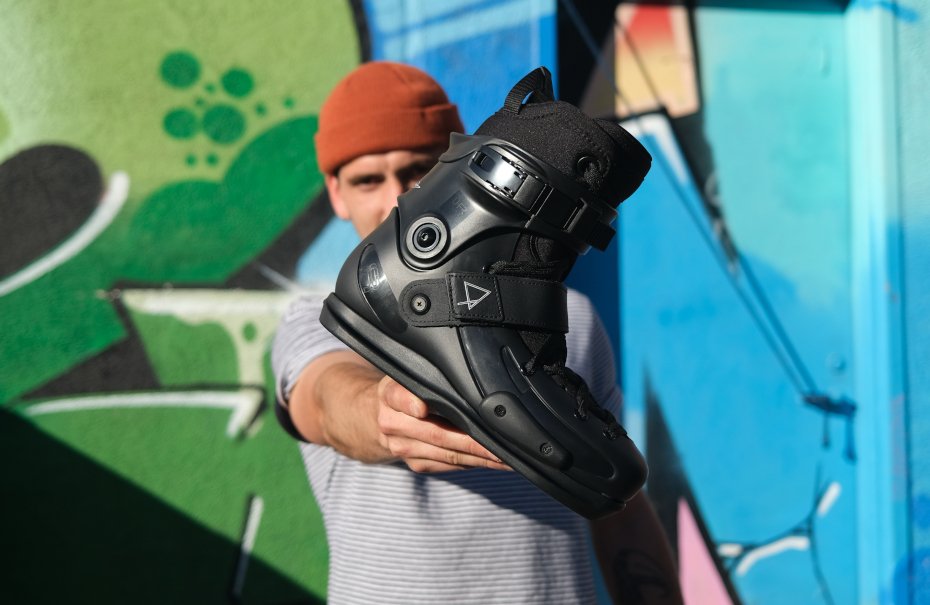
The only downside to UFR boot is pretty significant amount of material between foot and frame/grinded surface, making these a bit harder to tame for newcomers. Soulplates themselves are one of the fastest in the industry and slide well on just about anything.
We do not recommend getting a full AP setup with FLAT frame as a first pair of aggressive skates. This piece of hardware is more of a freeskating/aggressive hybrid, intended for experienced skaters and it will be very hard to learn tricks on it. It is better to get boot only version and then pick regular aggressive frames along with bearings and wheels separately.
Read more about these skates here.
USD Shadow Eugen Enin III and other USD Shadow skates (mondo point up to 30.3 cm)
It is a very unique skate, so if you want to learn more about it, we recommend reading our article. These skates do not have a traditional boot – instead, they are composed of outer skeleton (resembling snowboard bindings) and high cut liner with walkable sole.
Seeing that you can change cuff placement in relation to base (soulplate) and closure is composed of several straps, you can adjust these skates like no other. Skates have two sizes of the cuff, with two sizes of soulplates per each. Thanks to it, skates never appear too big.
Definitely not a model for everyone and a bit of an acquired taste, but it is worth to give them a go, as they perform very well and feel different than rest of aggressive models. We also have more in-depth article about them.
Seba CJ Carbon (mondo point up to 30.5 cm)
These are the only skates with integrated padding we list in this article. They fit wide and their toe-box (front of the boot) is shaped very generously, providing plenty of space. Carbon shell makes them light, but unlike many other skates using this material, they are not heat-moldable.
Warning: the similar Seba CJ2 Prime and Seba CJ2 boots use plastic shell instead and are available in less sizes. In addition, CJ2 Prime is of slimmer fit as it does have removable liner.
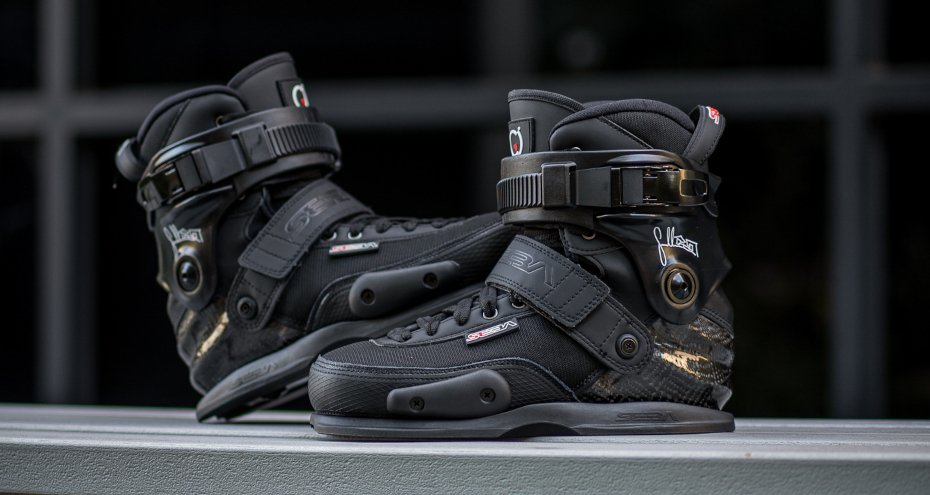
Boot comes with soulplates of very decent design and you can give it a personal touch thanks to custom kits. Furthermore, you can use these skates without a soulplate, which is very popular among wizard/flowskating fans (it is de facto the boot to go for in this case) but works well for putting together a more traditional setup for urban skating, too. CJ Carbon perform so excellent on big wheels that using them for aggressive inline skating almost seems like a waste of their potential.
A great pick if you look for lightweight and responsive boots for park, street or urban skating. Read more on these skates here.
Rollerblade Blank (mondo point up to 31.5 cm)
Blank shell is of medium width and works for people with regular to low instep. Furthermore, shell is made in more individual sizes than in most aggressive skates. The boot is pretty wide in toe-box area.
A huge advantage of this skate is thick shock-absorber conveniently integrated into bottom of the shell, locked in place and giving you a flush surface to rest foot on. There's about 2 cm of shock dampening material under the heel (not taking insole into consideration!) but you simply do not feel any excessive heel raise, just a little bit of tilt, which helps in maintaining proper skating stance. Liner is really good, made out of supportive foams and relatively thin, making for a more generous fit.
The frame is attached directly to the boot, without souplate between them, which gives you lower centre of gravity. Furthermore, you can get rid of soulplates entirely, making the boot a good pick if you want to put together a big wheel setup with UFS frame. In fact, Rollerblade had once made Fusion line of urban skates, which used earlier version of this shell. The boot worked excellent for this purpose – trust a man writing these words, who had two pairs of Fusions and skated them exclusively for about 6 years until they were so beaten they belonged in the bin. If you look for a plastic UFS skate to couple with big wheels, Blanks are simply perfect choice.
Blank are well designed skates made with quality materials and care Rollerblade is known for. You won't be disappointed!
Roces M12 UFS LO (mondo point up to 31.5)
Veterans of aggressive inline scene. M12 are the most popular aggressive skates in history and quite often can be found at very attractive price. The only downside is their narrow shell. But if you have long and slim feet, they should be perfect for you. It is possible to gain a bit more space using thinner liner (Intuitions are popular option), but they will never be a good pick for people with truly wide feet.
When it comes to other characteristics, they have soulplates which are narrower than in most skates, come with memory buckle. Furthermore, their stock fame coming in complete editions is a very decent choice for both flat and antirocker setups.
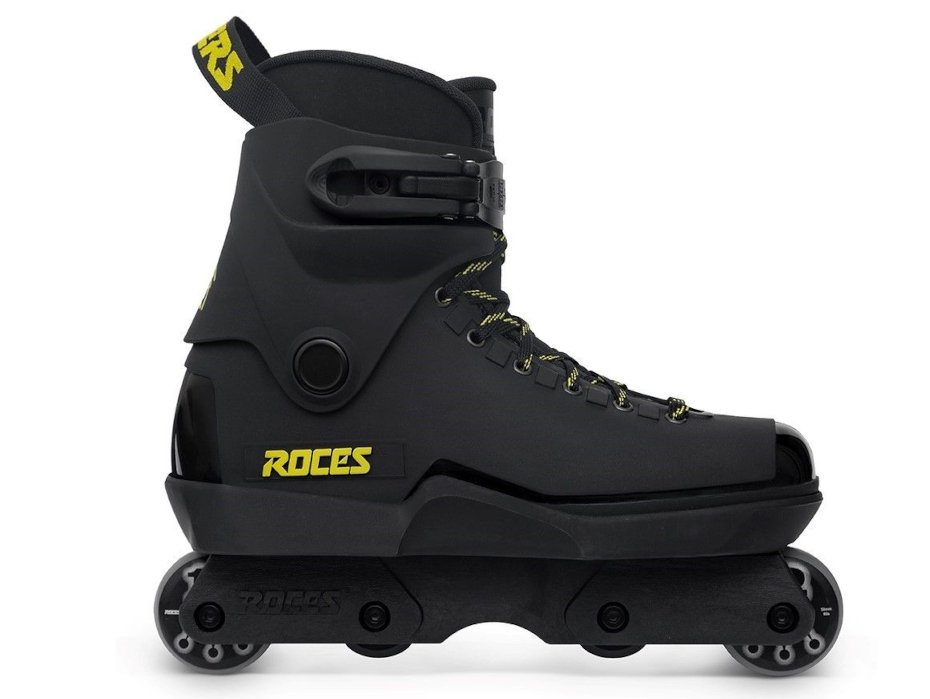
M12 LO are one of the most eco-friendly skates out there – recent editions have their shells and liners made with a significant amount of recycled materials and organic components like cornstarch. Thus, if you care about this kind of stuff (everyone should by now, really), it's another big plus.
M12 LO are the most widespread model, but there are other two variants worth a mention.
The first one is cheaper version of the skate, coming with higher cuff and made out of different plastic blend. Organic-derived components are gone, the skate is 100% made out of recycled plastic. A great way to put trash to a good use.
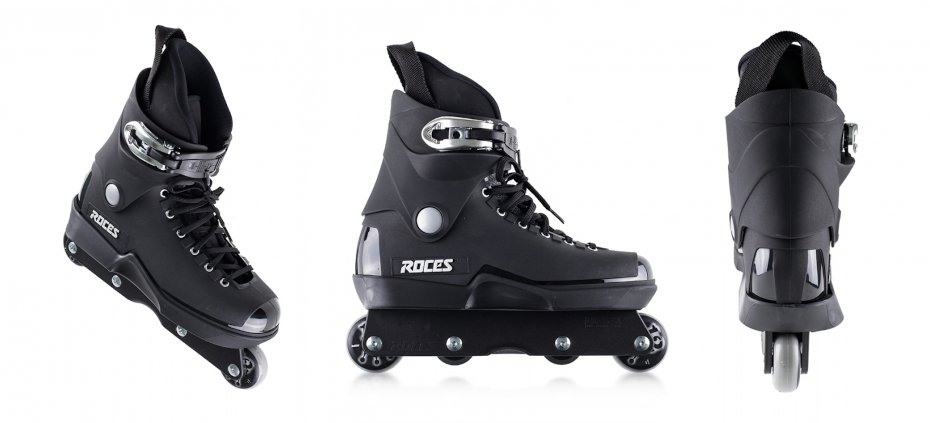
Liner is more basic, higher cut at the back. Frame is the bare minimum, not really suitable for anything other than learning how to roll on it and some simple soul based tricks by modern standards. Still, they are very cheap for a complete skate, so it is unfair to be picky in this case. Also, keep in mind that at some point in time, people were landing technical tricks on even more primitive frames.
Second unique version are Roces Dogma, which are reintroduction of Valo brand skates under a different name. You can read more about them here. These skates use the M12 shell but are bulkier, sporting wider soulplates and removable skin which covers the boot and gives it sneaker-like aesthetics.
Skin is ace up their sleeve. Back when Valo were made, many skaters performed toe-cut mod on them to get more room for their toes. A proper mod removes material from the front, leaving connection (bridge) between two sides of the shell as well as a base under toes, which is screwed to soulplate. You are essentially removing a “cap”. Thanks to outer skin hiding the cut shell, skate still looks good. Seeing that soulplates wrap around the boot fully and have pretty high “collar”, risk of damaging your toes is still minimal.
Roces 5th Element (mondo point up to 29.5 cm)
These skaters are great pick for people with wide feet. Without a shadow of doubt, this is the most spacious shell on the market. Furthermore, their upper is made out of softer material, working well for high instep, removing pressure points.
It is also worth to note that due to high volume of the shell and liner which isn’t that thick, many people may find that they need to pick a size or two smaller than in most skates. Roces even admit it themselves and recommend sizing down by one when compared to other skates. Thus, we recommend a bit of caution when choosing the right size for you - in case of any doubts, drop us an email asking for advice!
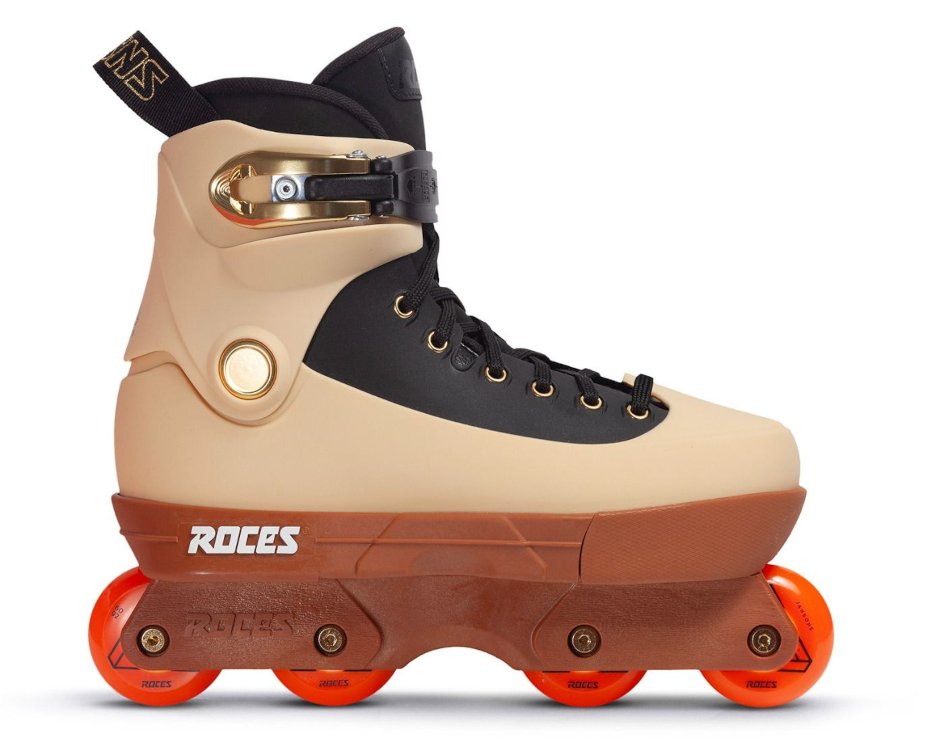
Skates have the same soulplate as M12 Dogma, so it is pretty wide. There’s a memory buckle and decent stock frame, too.
5th Element are a flagship skate of Roces brand, in theory. In practice, these differ in fit so greatly compared to M12 that it is almost impossible to find a person who likes them both equally. Thus, take 5th Element more as an alternative to older sibling rather than an obvious upgrade path.
When everything else fails: doop skates (in theory, no upper limit of modo point)
There are two doop models as of time of writing this article. These skates are made to be worn over your regular sneakers!
Doop skates are derived from earlier Xsjado skates, the same ones which evolved into USD Shadow. However, Powerslide has not abandoned the concept of using a regular shoe inside the skeleton, for dedicated liner, like in the latter.
Cuff have soft padding designed to work with low cut sneakers. There are two cuff sizes and two baseplate sizes. They are made for 229 mm – 275 mm and 275 mm – 315 mm mondo point feet respectively.
However, seeing that skeleton design is very open, you can put even larger foot inside – your toes may go beyond the baseplate, but hey, it is better than not having any skates at all! If you cannot find skates because of unusually long feet, this may be your only option. Maybe grab a pair of sneakers with reinforced toe area? My Adidas Terrex Swift Solo worked well enough in doop skeleton.
In the past, doop range of skates included multiple models and was pretty popular. Nowadays it has fallen out of grace, with Powerslide offering only two versions. Cheaper one comes with 275 mm long frame fitting 4x90 mm wheel setup. More expensive one comes with 250 mm frame and 3x100 mm setup.
You surely must realise after reading this article that cheaper one is better suited for people with big feet. Furthermore, because skeleton is more flexible than full hardboot, having lower centre of gravity on 90 mm wheels is also preferable.
These skates are compatible with all Trinity frames. But that’s not all, as they have one additional ace up in their sleeve!
As their design is based on Xsjado skates, you can replace their baseplate with Xsjado 2.0/Shadow soulplates and convert them into UFS compatible model. Just remember to pick the right soulplate size: XS and S fit the smaller cuff, while M and L fit larger one. You will also need velcro straps for locking the toes and hardware to mount the frames. Of course, frames and wheels, too.
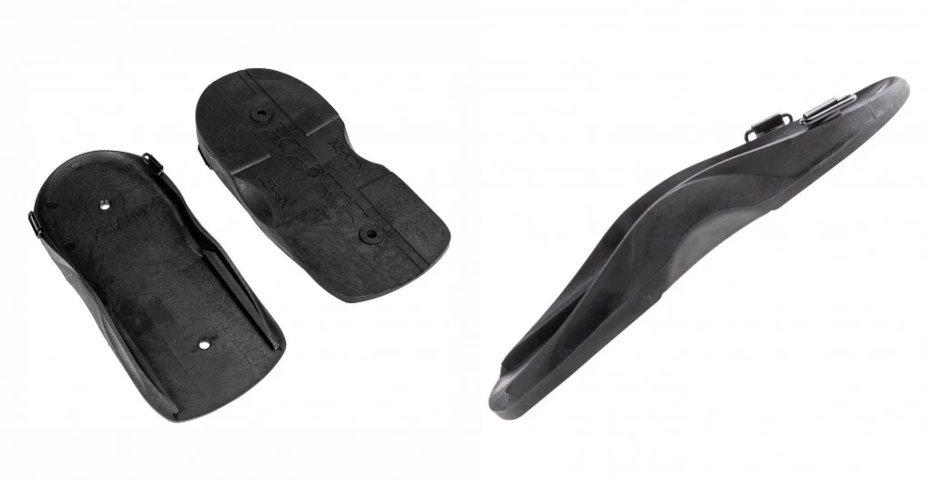
In practice, you can convert a pair of doop into fully functional aggressive skates. It is basically the same thing as old Xsjado 2.0 skates, just look below.
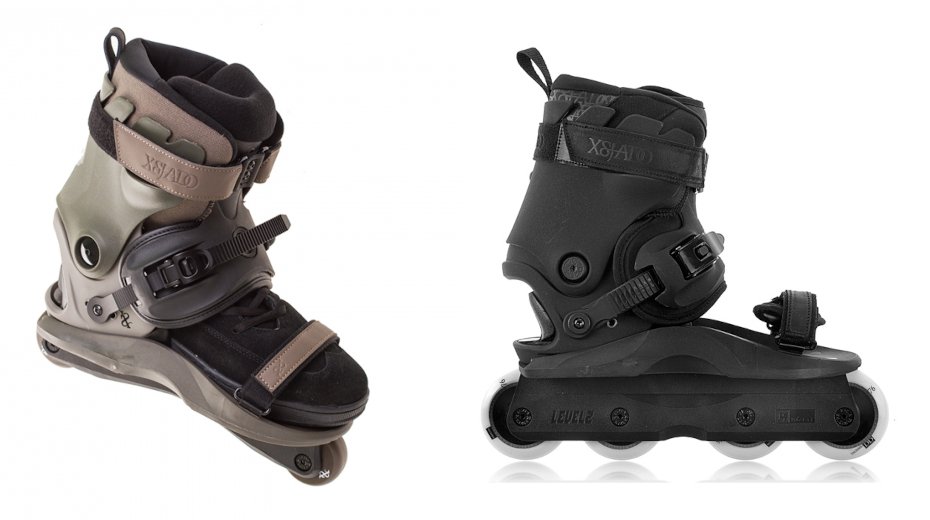
Furthermore, thanks to Xsjado/Shadow soulplate being more robust and rigid, this mod can make the skates better suited for freeskating elements like jumps and slides after you couple it with a decent big wheel UFS frame.
Last but not least - these skates are perfect choice for commuting.
What else can you do?
If skates are a match length-wise, but you feel pressure from the sides, it is worth to take the liner out, take a good look at it and evaluate if replacing it with thinner model could give you a better fit.
Replacing stock liner for a thinner one is most often used to fit into smaller shell size, but nothing stops you from using it to gain more space inside without downsizing. This, of course, works best in wide skates which come with thick padding out of the box.
Popular picks for stock liner replacement are MyFit 2nd Skin, Intution Skate V2 and Intuition Premium.
If you have a high instep, take the shock-absorber out and see if boot have even surface for your foot to rest on. In many skates, the absorber isn't necessary to use the boot, so you can take it out or replace with thinnner one, lowering placement of the foot inside the shell.
Going the other way around and adding another shock absorber also can make sense in some cases. If your ankle bones are placed very low, raising your heel can relieve pressure on them, as cuffs are wider in top part.
A lot of higher end models come with thicker insoles, designed to provide more comfort and additional vibration dampening. Quite often they have pronounced arch support. In such cases, you can get additional space inside the boot by using thiner and flatter insole. In general, if you feel discomfort in midfoot area it is worth to check how the skate feels without insole.
Last thing you can do to gain more space is stretching out the shells after treating them with heat. Ski service shops often have gear for such procedure, seeing that boot fitting is elevated to form of art among skiers. Skates are not made of the exact same materials as skiing boots, but they are also thermoplastic and this can be used to remove pressure points. In some skates it is even possible to stretch out the heel area a bit to the back, gaining a few mm in length.
What else to say – ask, visit, try on!
If you have any doubts about choosing skates size, feel free to drop us an email to info@bladeville.com
In addition, it you are in or plan to visit Poland, we have brick and mortar shops in cities of Katowice, Gdańsk and Warsaw – our staff will be happy to help.


